Alida Scholtz: Literature Review on Connected Vehicles and MaaS
VerifiedAdded on 2022/08/15
|12
|4193
|19
Literature Review
AI Summary
This literature review by Alida Scholtz examines the evolving landscape of connected vehicles and Mobility-as-a-Service (MaaS). It explores the technological advancements, including V2V communication and the integration of connected car technology, and their impact on the automotive industry. The review discusses the potential of MaaS to transform transportation by improving accessibility and offering new services. It delves into the implications for car rental companies, analyzing how they will adapt to new consumer demands and technological shifts. The review also highlights the potential benefits of connected vehicles, such as enhanced safety, reduced travel times, and improved traffic management. Furthermore, the review examines the future perspective of rental companies, emphasizing the incorporation of connected vehicle technology and MaaS into their operational activities. It explores the strengths, weaknesses, opportunities, and threats associated with this technological shift, providing a comprehensive overview of the connected vehicle ecosystem and its impact on the broader mobility market.
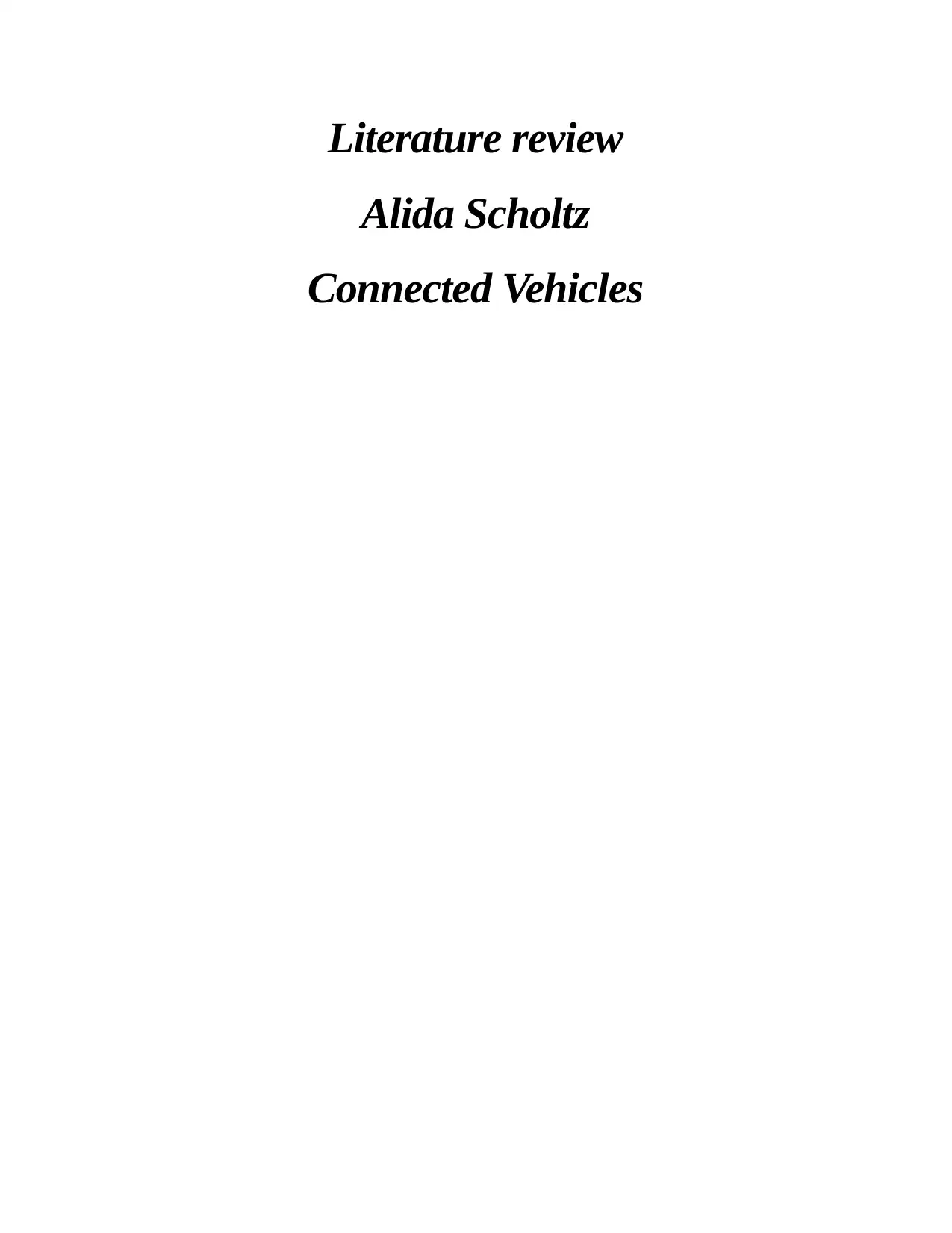
Literature review
Alida Scholtz
Connected Vehicles
Alida Scholtz
Connected Vehicles
Paraphrase This Document
Need a fresh take? Get an instant paraphrase of this document with our AI Paraphraser
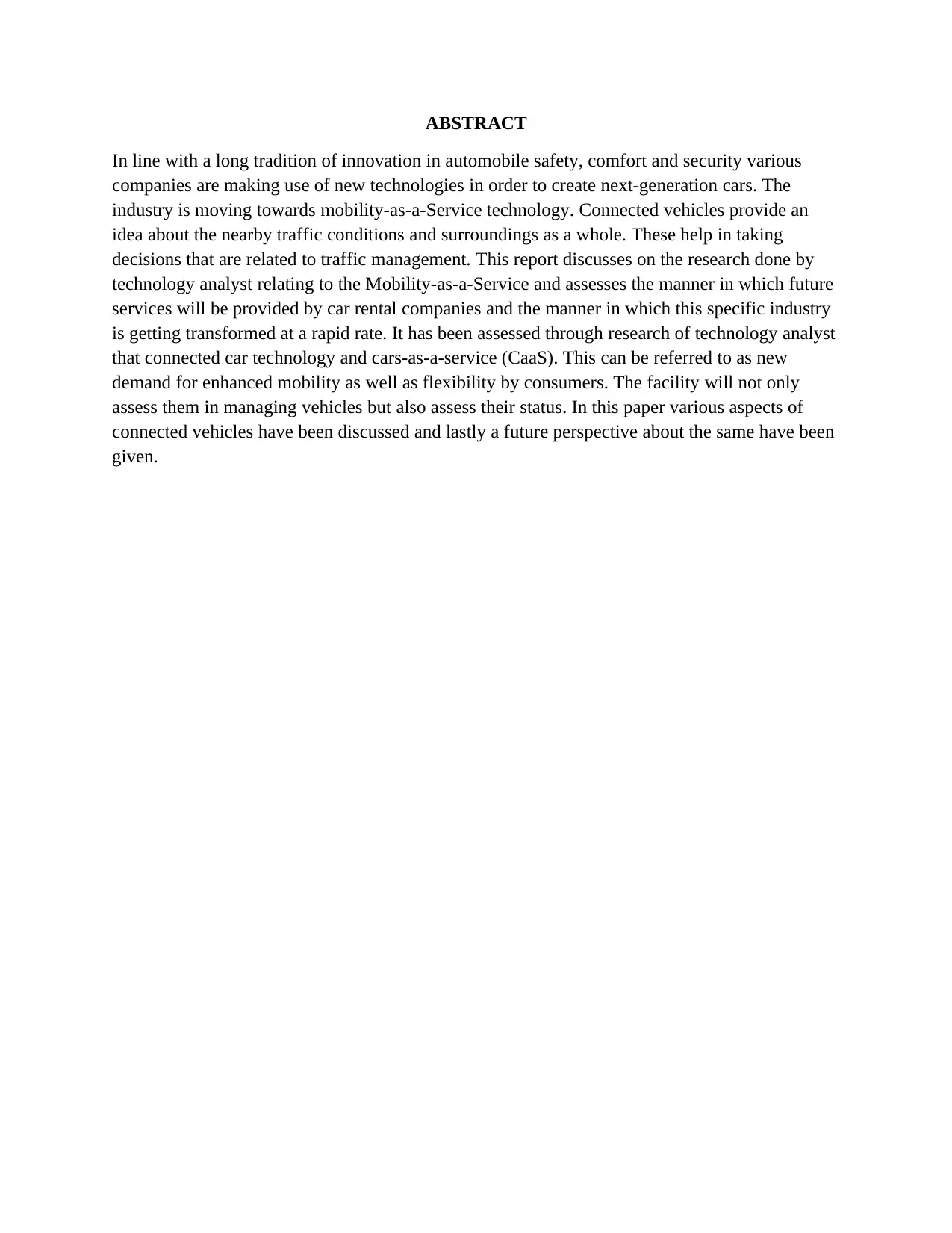
ABSTRACT
In line with a long tradition of innovation in automobile safety, comfort and security various
companies are making use of new technologies in order to create next-generation cars. The
industry is moving towards mobility-as-a-Service technology. Connected vehicles provide an
idea about the nearby traffic conditions and surroundings as a whole. These help in taking
decisions that are related to traffic management. This report discusses on the research done by
technology analyst relating to the Mobility-as-a-Service and assesses the manner in which future
services will be provided by car rental companies and the manner in which this specific industry
is getting transformed at a rapid rate. It has been assessed through research of technology analyst
that connected car technology and cars-as-a-service (CaaS). This can be referred to as new
demand for enhanced mobility as well as flexibility by consumers. The facility will not only
assess them in managing vehicles but also assess their status. In this paper various aspects of
connected vehicles have been discussed and lastly a future perspective about the same have been
given.
In line with a long tradition of innovation in automobile safety, comfort and security various
companies are making use of new technologies in order to create next-generation cars. The
industry is moving towards mobility-as-a-Service technology. Connected vehicles provide an
idea about the nearby traffic conditions and surroundings as a whole. These help in taking
decisions that are related to traffic management. This report discusses on the research done by
technology analyst relating to the Mobility-as-a-Service and assesses the manner in which future
services will be provided by car rental companies and the manner in which this specific industry
is getting transformed at a rapid rate. It has been assessed through research of technology analyst
that connected car technology and cars-as-a-service (CaaS). This can be referred to as new
demand for enhanced mobility as well as flexibility by consumers. The facility will not only
assess them in managing vehicles but also assess their status. In this paper various aspects of
connected vehicles have been discussed and lastly a future perspective about the same have been
given.
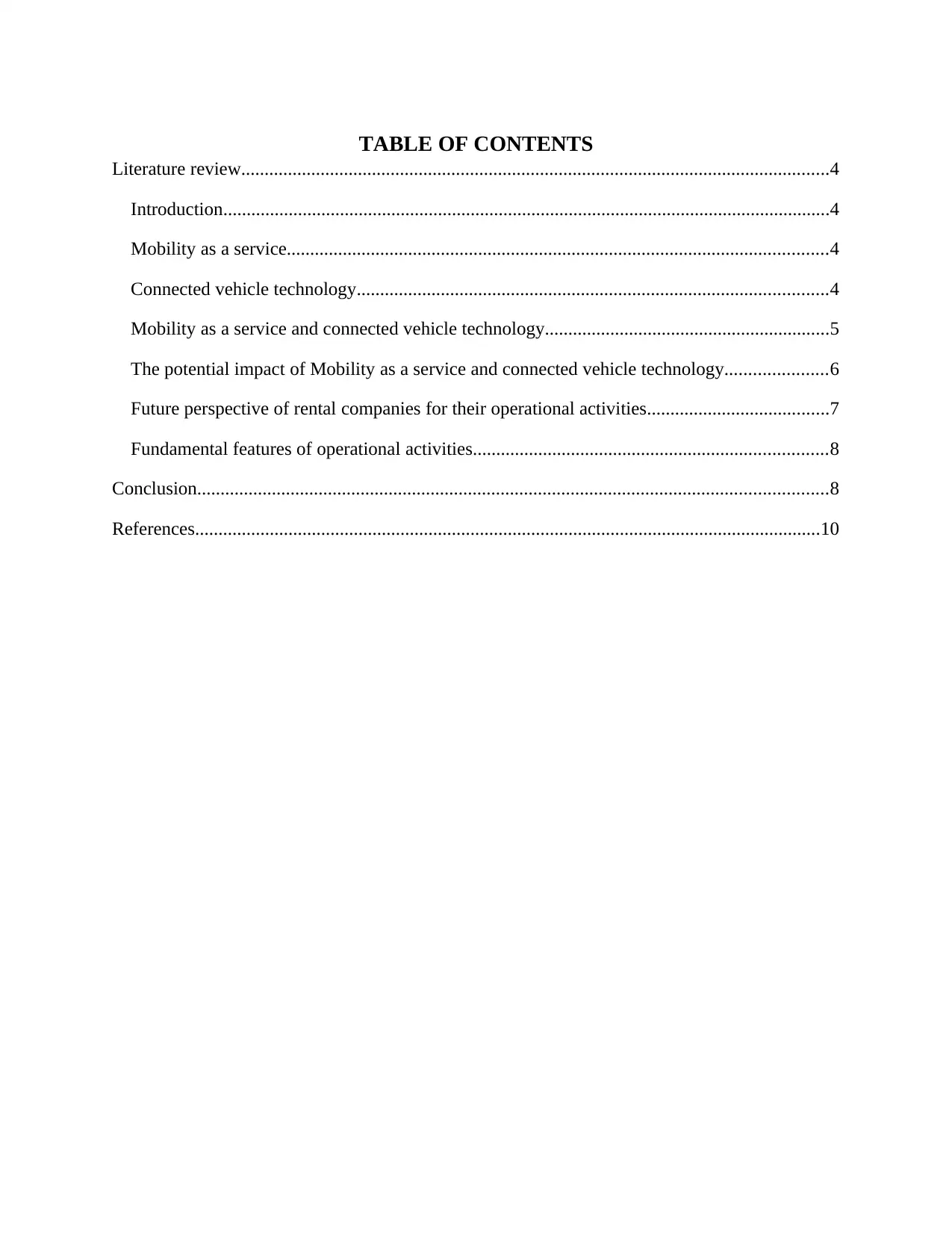
TABLE OF CONTENTS
Literature review..............................................................................................................................4
Introduction..................................................................................................................................4
Mobility as a service....................................................................................................................4
Connected vehicle technology.....................................................................................................4
Mobility as a service and connected vehicle technology.............................................................5
The potential impact of Mobility as a service and connected vehicle technology......................6
Future perspective of rental companies for their operational activities.......................................7
Fundamental features of operational activities............................................................................8
Conclusion.......................................................................................................................................8
References......................................................................................................................................10
Literature review..............................................................................................................................4
Introduction..................................................................................................................................4
Mobility as a service....................................................................................................................4
Connected vehicle technology.....................................................................................................4
Mobility as a service and connected vehicle technology.............................................................5
The potential impact of Mobility as a service and connected vehicle technology......................6
Future perspective of rental companies for their operational activities.......................................7
Fundamental features of operational activities............................................................................8
Conclusion.......................................................................................................................................8
References......................................................................................................................................10
⊘ This is a preview!⊘
Do you want full access?
Subscribe today to unlock all pages.

Trusted by 1+ million students worldwide
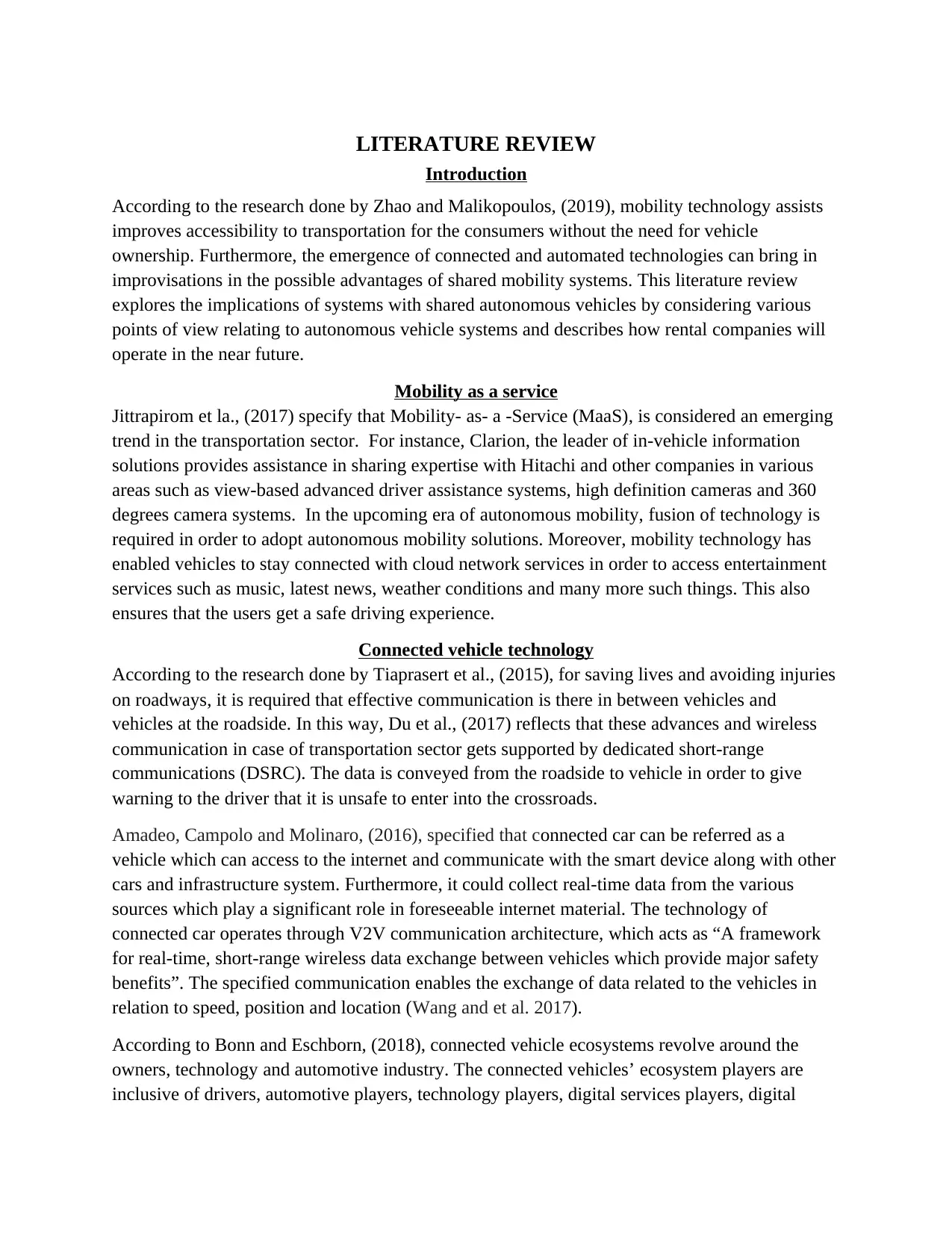
LITERATURE REVIEW
Introduction
According to the research done by Zhao and Malikopoulos, (2019), mobility technology assists
improves accessibility to transportation for the consumers without the need for vehicle
ownership. Furthermore, the emergence of connected and automated technologies can bring in
improvisations in the possible advantages of shared mobility systems. This literature review
explores the implications of systems with shared autonomous vehicles by considering various
points of view relating to autonomous vehicle systems and describes how rental companies will
operate in the near future.
Mobility as a service
Jittrapirom et la., (2017) specify that Mobility- as- a -Service (MaaS), is considered an emerging
trend in the transportation sector. For instance, Clarion, the leader of in-vehicle information
solutions provides assistance in sharing expertise with Hitachi and other companies in various
areas such as view-based advanced driver assistance systems, high definition cameras and 360
degrees camera systems. In the upcoming era of autonomous mobility, fusion of technology is
required in order to adopt autonomous mobility solutions. Moreover, mobility technology has
enabled vehicles to stay connected with cloud network services in order to access entertainment
services such as music, latest news, weather conditions and many more such things. This also
ensures that the users get a safe driving experience.
Connected vehicle technology
According to the research done by Tiaprasert et al., (2015), for saving lives and avoiding injuries
on roadways, it is required that effective communication is there in between vehicles and
vehicles at the roadside. In this way, Du et al., (2017) reflects that these advances and wireless
communication in case of transportation sector gets supported by dedicated short-range
communications (DSRC). The data is conveyed from the roadside to vehicle in order to give
warning to the driver that it is unsafe to enter into the crossroads.
Amadeo, Campolo and Molinaro, (2016), specified that connected car can be referred as a
vehicle which can access to the internet and communicate with the smart device along with other
cars and infrastructure system. Furthermore, it could collect real-time data from the various
sources which play a significant role in foreseeable internet material. The technology of
connected car operates through V2V communication architecture, which acts as “A framework
for real-time, short-range wireless data exchange between vehicles which provide major safety
benefits”. The specified communication enables the exchange of data related to the vehicles in
relation to speed, position and location (Wang and et al. 2017).
According to Bonn and Eschborn, (2018), connected vehicle ecosystems revolve around the
owners, technology and automotive industry. The connected vehicles’ ecosystem players are
inclusive of drivers, automotive players, technology players, digital services players, digital
Introduction
According to the research done by Zhao and Malikopoulos, (2019), mobility technology assists
improves accessibility to transportation for the consumers without the need for vehicle
ownership. Furthermore, the emergence of connected and automated technologies can bring in
improvisations in the possible advantages of shared mobility systems. This literature review
explores the implications of systems with shared autonomous vehicles by considering various
points of view relating to autonomous vehicle systems and describes how rental companies will
operate in the near future.
Mobility as a service
Jittrapirom et la., (2017) specify that Mobility- as- a -Service (MaaS), is considered an emerging
trend in the transportation sector. For instance, Clarion, the leader of in-vehicle information
solutions provides assistance in sharing expertise with Hitachi and other companies in various
areas such as view-based advanced driver assistance systems, high definition cameras and 360
degrees camera systems. In the upcoming era of autonomous mobility, fusion of technology is
required in order to adopt autonomous mobility solutions. Moreover, mobility technology has
enabled vehicles to stay connected with cloud network services in order to access entertainment
services such as music, latest news, weather conditions and many more such things. This also
ensures that the users get a safe driving experience.
Connected vehicle technology
According to the research done by Tiaprasert et al., (2015), for saving lives and avoiding injuries
on roadways, it is required that effective communication is there in between vehicles and
vehicles at the roadside. In this way, Du et al., (2017) reflects that these advances and wireless
communication in case of transportation sector gets supported by dedicated short-range
communications (DSRC). The data is conveyed from the roadside to vehicle in order to give
warning to the driver that it is unsafe to enter into the crossroads.
Amadeo, Campolo and Molinaro, (2016), specified that connected car can be referred as a
vehicle which can access to the internet and communicate with the smart device along with other
cars and infrastructure system. Furthermore, it could collect real-time data from the various
sources which play a significant role in foreseeable internet material. The technology of
connected car operates through V2V communication architecture, which acts as “A framework
for real-time, short-range wireless data exchange between vehicles which provide major safety
benefits”. The specified communication enables the exchange of data related to the vehicles in
relation to speed, position and location (Wang and et al. 2017).
According to Bonn and Eschborn, (2018), connected vehicle ecosystems revolve around the
owners, technology and automotive industry. The connected vehicles’ ecosystem players are
inclusive of drivers, automotive players, technology players, digital services players, digital
Paraphrase This Document
Need a fresh take? Get an instant paraphrase of this document with our AI Paraphraser
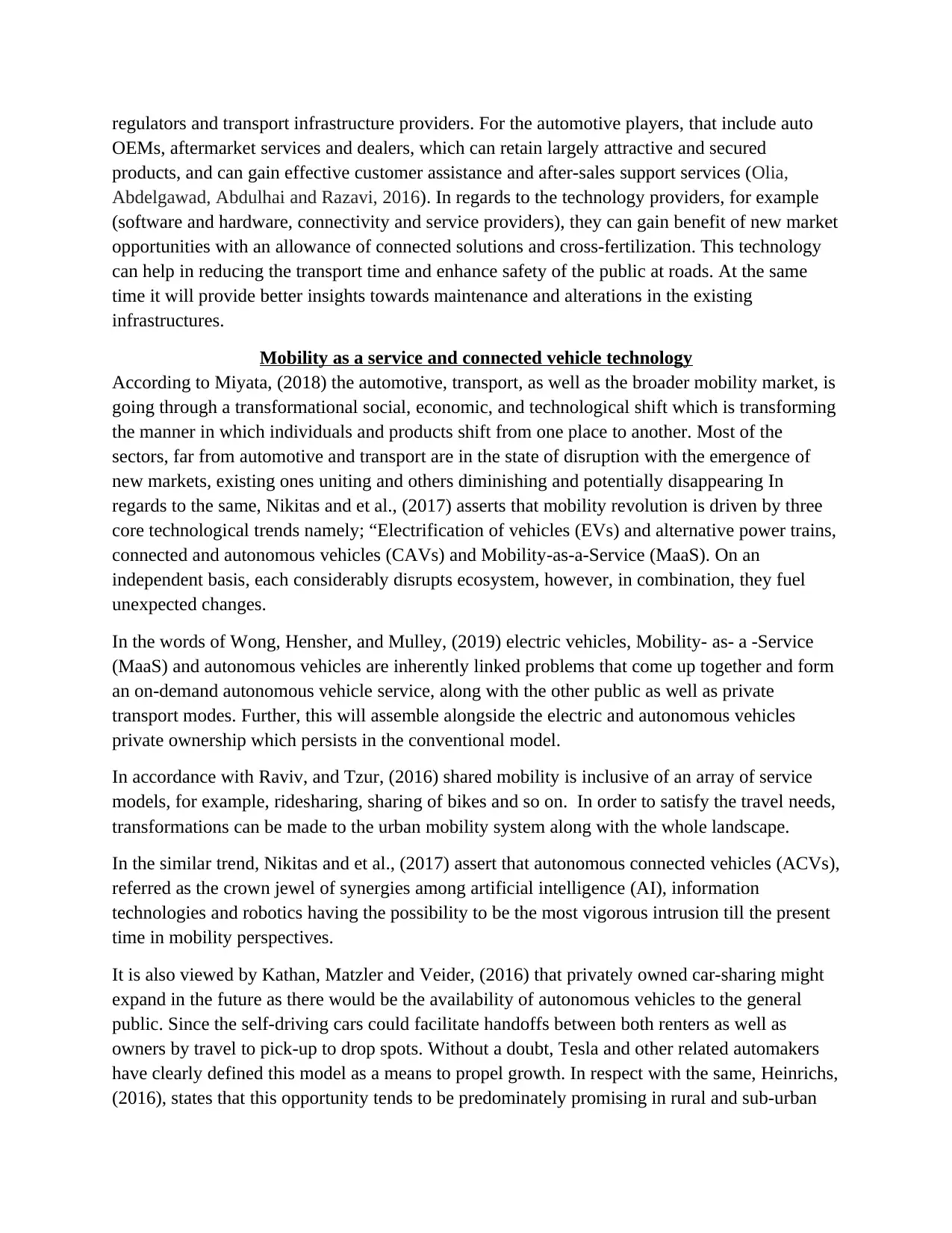
regulators and transport infrastructure providers. For the automotive players, that include auto
OEMs, aftermarket services and dealers, which can retain largely attractive and secured
products, and can gain effective customer assistance and after-sales support services (Olia,
Abdelgawad, Abdulhai and Razavi, 2016). In regards to the technology providers, for example
(software and hardware, connectivity and service providers), they can gain benefit of new market
opportunities with an allowance of connected solutions and cross-fertilization. This technology
can help in reducing the transport time and enhance safety of the public at roads. At the same
time it will provide better insights towards maintenance and alterations in the existing
infrastructures.
Mobility as a service and connected vehicle technology
According to Miyata, (2018) the automotive, transport, as well as the broader mobility market, is
going through a transformational social, economic, and technological shift which is transforming
the manner in which individuals and products shift from one place to another. Most of the
sectors, far from automotive and transport are in the state of disruption with the emergence of
new markets, existing ones uniting and others diminishing and potentially disappearing In
regards to the same, Nikitas and et al., (2017) asserts that mobility revolution is driven by three
core technological trends namely; “Electrification of vehicles (EVs) and alternative power trains,
connected and autonomous vehicles (CAVs) and Mobility-as-a-Service (MaaS). On an
independent basis, each considerably disrupts ecosystem, however, in combination, they fuel
unexpected changes.
In the words of Wong, Hensher, and Mulley, (2019) electric vehicles, Mobility- as- a -Service
(MaaS) and autonomous vehicles are inherently linked problems that come up together and form
an on-demand autonomous vehicle service, along with the other public as well as private
transport modes. Further, this will assemble alongside the electric and autonomous vehicles
private ownership which persists in the conventional model.
In accordance with Raviv, and Tzur, (2016) shared mobility is inclusive of an array of service
models, for example, ridesharing, sharing of bikes and so on. In order to satisfy the travel needs,
transformations can be made to the urban mobility system along with the whole landscape.
In the similar trend, Nikitas and et al., (2017) assert that autonomous connected vehicles (ACVs),
referred as the crown jewel of synergies among artificial intelligence (AI), information
technologies and robotics having the possibility to be the most vigorous intrusion till the present
time in mobility perspectives.
It is also viewed by Kathan, Matzler and Veider, (2016) that privately owned car-sharing might
expand in the future as there would be the availability of autonomous vehicles to the general
public. Since the self-driving cars could facilitate handoffs between both renters as well as
owners by travel to pick-up to drop spots. Without a doubt, Tesla and other related automakers
have clearly defined this model as a means to propel growth. In respect with the same, Heinrichs,
(2016), states that this opportunity tends to be predominately promising in rural and sub-urban
OEMs, aftermarket services and dealers, which can retain largely attractive and secured
products, and can gain effective customer assistance and after-sales support services (Olia,
Abdelgawad, Abdulhai and Razavi, 2016). In regards to the technology providers, for example
(software and hardware, connectivity and service providers), they can gain benefit of new market
opportunities with an allowance of connected solutions and cross-fertilization. This technology
can help in reducing the transport time and enhance safety of the public at roads. At the same
time it will provide better insights towards maintenance and alterations in the existing
infrastructures.
Mobility as a service and connected vehicle technology
According to Miyata, (2018) the automotive, transport, as well as the broader mobility market, is
going through a transformational social, economic, and technological shift which is transforming
the manner in which individuals and products shift from one place to another. Most of the
sectors, far from automotive and transport are in the state of disruption with the emergence of
new markets, existing ones uniting and others diminishing and potentially disappearing In
regards to the same, Nikitas and et al., (2017) asserts that mobility revolution is driven by three
core technological trends namely; “Electrification of vehicles (EVs) and alternative power trains,
connected and autonomous vehicles (CAVs) and Mobility-as-a-Service (MaaS). On an
independent basis, each considerably disrupts ecosystem, however, in combination, they fuel
unexpected changes.
In the words of Wong, Hensher, and Mulley, (2019) electric vehicles, Mobility- as- a -Service
(MaaS) and autonomous vehicles are inherently linked problems that come up together and form
an on-demand autonomous vehicle service, along with the other public as well as private
transport modes. Further, this will assemble alongside the electric and autonomous vehicles
private ownership which persists in the conventional model.
In accordance with Raviv, and Tzur, (2016) shared mobility is inclusive of an array of service
models, for example, ridesharing, sharing of bikes and so on. In order to satisfy the travel needs,
transformations can be made to the urban mobility system along with the whole landscape.
In the similar trend, Nikitas and et al., (2017) assert that autonomous connected vehicles (ACVs),
referred as the crown jewel of synergies among artificial intelligence (AI), information
technologies and robotics having the possibility to be the most vigorous intrusion till the present
time in mobility perspectives.
It is also viewed by Kathan, Matzler and Veider, (2016) that privately owned car-sharing might
expand in the future as there would be the availability of autonomous vehicles to the general
public. Since the self-driving cars could facilitate handoffs between both renters as well as
owners by travel to pick-up to drop spots. Without a doubt, Tesla and other related automakers
have clearly defined this model as a means to propel growth. In respect with the same, Heinrichs,
(2016), states that this opportunity tends to be predominately promising in rural and sub-urban
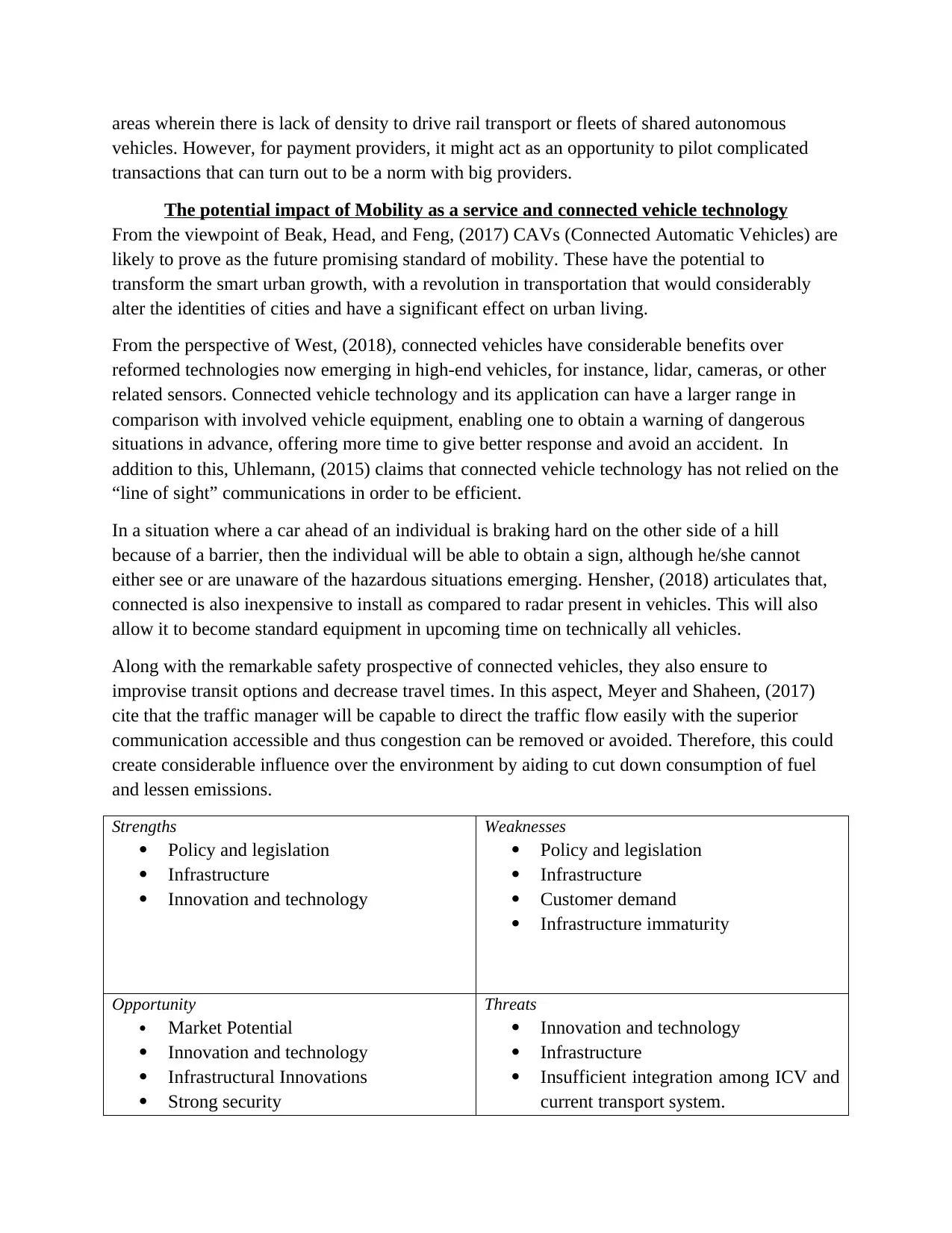
areas wherein there is lack of density to drive rail transport or fleets of shared autonomous
vehicles. However, for payment providers, it might act as an opportunity to pilot complicated
transactions that can turn out to be a norm with big providers.
The potential impact of Mobility as a service and connected vehicle technology
From the viewpoint of Beak, Head, and Feng, (2017) CAVs (Connected Automatic Vehicles) are
likely to prove as the future promising standard of mobility. These have the potential to
transform the smart urban growth, with a revolution in transportation that would considerably
alter the identities of cities and have a significant effect on urban living.
From the perspective of West, (2018), connected vehicles have considerable benefits over
reformed technologies now emerging in high-end vehicles, for instance, lidar, cameras, or other
related sensors. Connected vehicle technology and its application can have a larger range in
comparison with involved vehicle equipment, enabling one to obtain a warning of dangerous
situations in advance, offering more time to give better response and avoid an accident. In
addition to this, Uhlemann, (2015) claims that connected vehicle technology has not relied on the
“line of sight” communications in order to be efficient.
In a situation where a car ahead of an individual is braking hard on the other side of a hill
because of a barrier, then the individual will be able to obtain a sign, although he/she cannot
either see or are unaware of the hazardous situations emerging. Hensher, (2018) articulates that,
connected is also inexpensive to install as compared to radar present in vehicles. This will also
allow it to become standard equipment in upcoming time on technically all vehicles.
Along with the remarkable safety prospective of connected vehicles, they also ensure to
improvise transit options and decrease travel times. In this aspect, Meyer and Shaheen, (2017)
cite that the traffic manager will be capable to direct the traffic flow easily with the superior
communication accessible and thus congestion can be removed or avoided. Therefore, this could
create considerable influence over the environment by aiding to cut down consumption of fuel
and lessen emissions.
Strengths
Policy and legislation
Infrastructure
Innovation and technology
Weaknesses
Policy and legislation
Infrastructure
Customer demand
Infrastructure immaturity
Opportunity
Market Potential
Innovation and technology
Infrastructural Innovations
Strong security
Threats
Innovation and technology
Infrastructure
Insufficient integration among ICV and
current transport system.
vehicles. However, for payment providers, it might act as an opportunity to pilot complicated
transactions that can turn out to be a norm with big providers.
The potential impact of Mobility as a service and connected vehicle technology
From the viewpoint of Beak, Head, and Feng, (2017) CAVs (Connected Automatic Vehicles) are
likely to prove as the future promising standard of mobility. These have the potential to
transform the smart urban growth, with a revolution in transportation that would considerably
alter the identities of cities and have a significant effect on urban living.
From the perspective of West, (2018), connected vehicles have considerable benefits over
reformed technologies now emerging in high-end vehicles, for instance, lidar, cameras, or other
related sensors. Connected vehicle technology and its application can have a larger range in
comparison with involved vehicle equipment, enabling one to obtain a warning of dangerous
situations in advance, offering more time to give better response and avoid an accident. In
addition to this, Uhlemann, (2015) claims that connected vehicle technology has not relied on the
“line of sight” communications in order to be efficient.
In a situation where a car ahead of an individual is braking hard on the other side of a hill
because of a barrier, then the individual will be able to obtain a sign, although he/she cannot
either see or are unaware of the hazardous situations emerging. Hensher, (2018) articulates that,
connected is also inexpensive to install as compared to radar present in vehicles. This will also
allow it to become standard equipment in upcoming time on technically all vehicles.
Along with the remarkable safety prospective of connected vehicles, they also ensure to
improvise transit options and decrease travel times. In this aspect, Meyer and Shaheen, (2017)
cite that the traffic manager will be capable to direct the traffic flow easily with the superior
communication accessible and thus congestion can be removed or avoided. Therefore, this could
create considerable influence over the environment by aiding to cut down consumption of fuel
and lessen emissions.
Strengths
Policy and legislation
Infrastructure
Innovation and technology
Weaknesses
Policy and legislation
Infrastructure
Customer demand
Infrastructure immaturity
Opportunity
Market Potential
Innovation and technology
Infrastructural Innovations
Strong security
Threats
Innovation and technology
Infrastructure
Insufficient integration among ICV and
current transport system.
⊘ This is a preview!⊘
Do you want full access?
Subscribe today to unlock all pages.

Trusted by 1+ million students worldwide
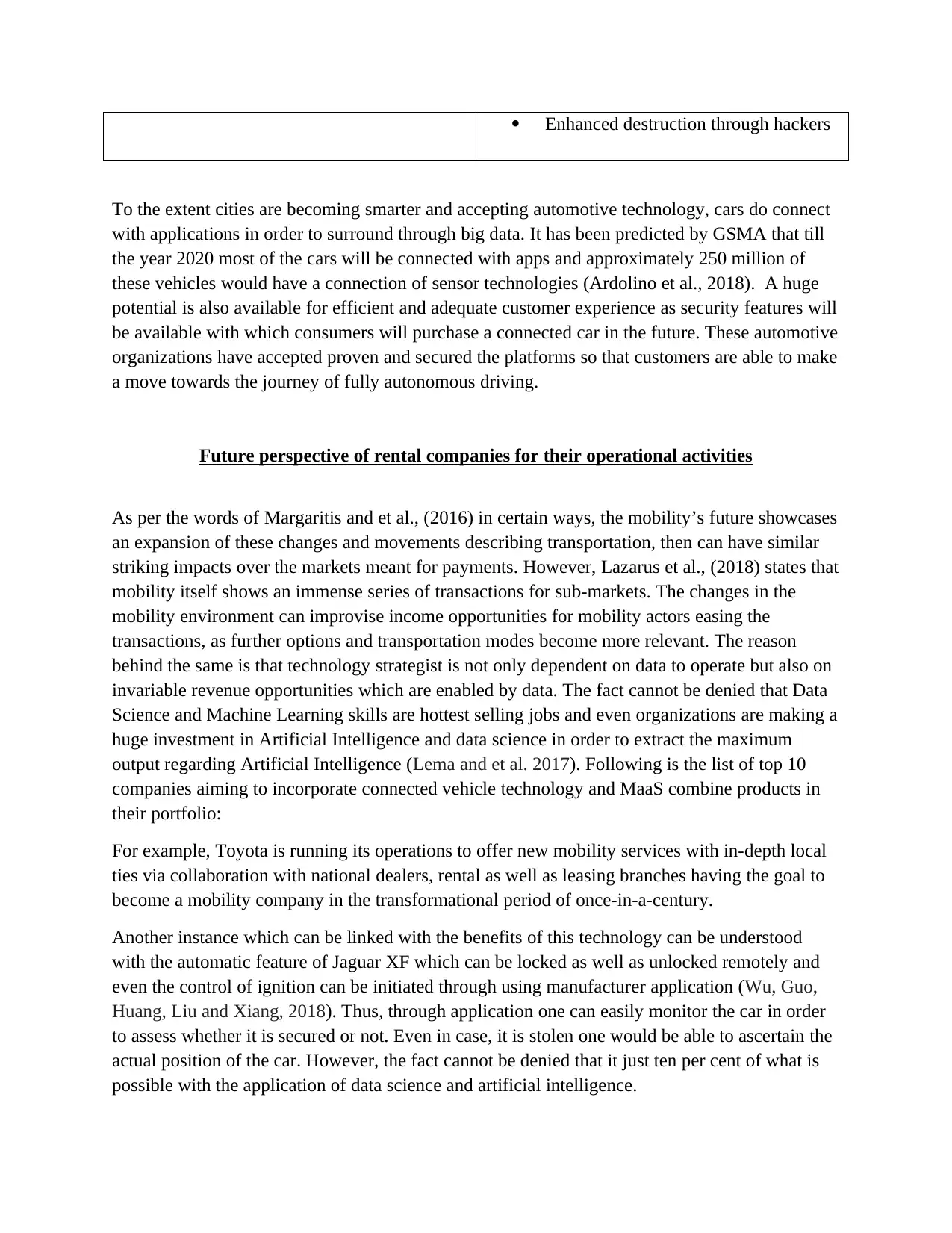
Enhanced destruction through hackers
To the extent cities are becoming smarter and accepting automotive technology, cars do connect
with applications in order to surround through big data. It has been predicted by GSMA that till
the year 2020 most of the cars will be connected with apps and approximately 250 million of
these vehicles would have a connection of sensor technologies (Ardolino et al., 2018). A huge
potential is also available for efficient and adequate customer experience as security features will
be available with which consumers will purchase a connected car in the future. These automotive
organizations have accepted proven and secured the platforms so that customers are able to make
a move towards the journey of fully autonomous driving.
Future perspective of rental companies for their operational activities
As per the words of Margaritis and et al., (2016) in certain ways, the mobility’s future showcases
an expansion of these changes and movements describing transportation, then can have similar
striking impacts over the markets meant for payments. However, Lazarus et al., (2018) states that
mobility itself shows an immense series of transactions for sub-markets. The changes in the
mobility environment can improvise income opportunities for mobility actors easing the
transactions, as further options and transportation modes become more relevant. The reason
behind the same is that technology strategist is not only dependent on data to operate but also on
invariable revenue opportunities which are enabled by data. The fact cannot be denied that Data
Science and Machine Learning skills are hottest selling jobs and even organizations are making a
huge investment in Artificial Intelligence and data science in order to extract the maximum
output regarding Artificial Intelligence (Lema and et al. 2017). Following is the list of top 10
companies aiming to incorporate connected vehicle technology and MaaS combine products in
their portfolio:
For example, Toyota is running its operations to offer new mobility services with in-depth local
ties via collaboration with national dealers, rental as well as leasing branches having the goal to
become a mobility company in the transformational period of once-in-a-century.
Another instance which can be linked with the benefits of this technology can be understood
with the automatic feature of Jaguar XF which can be locked as well as unlocked remotely and
even the control of ignition can be initiated through using manufacturer application (Wu, Guo,
Huang, Liu and Xiang, 2018). Thus, through application one can easily monitor the car in order
to assess whether it is secured or not. Even in case, it is stolen one would be able to ascertain the
actual position of the car. However, the fact cannot be denied that it just ten per cent of what is
possible with the application of data science and artificial intelligence.
To the extent cities are becoming smarter and accepting automotive technology, cars do connect
with applications in order to surround through big data. It has been predicted by GSMA that till
the year 2020 most of the cars will be connected with apps and approximately 250 million of
these vehicles would have a connection of sensor technologies (Ardolino et al., 2018). A huge
potential is also available for efficient and adequate customer experience as security features will
be available with which consumers will purchase a connected car in the future. These automotive
organizations have accepted proven and secured the platforms so that customers are able to make
a move towards the journey of fully autonomous driving.
Future perspective of rental companies for their operational activities
As per the words of Margaritis and et al., (2016) in certain ways, the mobility’s future showcases
an expansion of these changes and movements describing transportation, then can have similar
striking impacts over the markets meant for payments. However, Lazarus et al., (2018) states that
mobility itself shows an immense series of transactions for sub-markets. The changes in the
mobility environment can improvise income opportunities for mobility actors easing the
transactions, as further options and transportation modes become more relevant. The reason
behind the same is that technology strategist is not only dependent on data to operate but also on
invariable revenue opportunities which are enabled by data. The fact cannot be denied that Data
Science and Machine Learning skills are hottest selling jobs and even organizations are making a
huge investment in Artificial Intelligence and data science in order to extract the maximum
output regarding Artificial Intelligence (Lema and et al. 2017). Following is the list of top 10
companies aiming to incorporate connected vehicle technology and MaaS combine products in
their portfolio:
For example, Toyota is running its operations to offer new mobility services with in-depth local
ties via collaboration with national dealers, rental as well as leasing branches having the goal to
become a mobility company in the transformational period of once-in-a-century.
Another instance which can be linked with the benefits of this technology can be understood
with the automatic feature of Jaguar XF which can be locked as well as unlocked remotely and
even the control of ignition can be initiated through using manufacturer application (Wu, Guo,
Huang, Liu and Xiang, 2018). Thus, through application one can easily monitor the car in order
to assess whether it is secured or not. Even in case, it is stolen one would be able to ascertain the
actual position of the car. However, the fact cannot be denied that it just ten per cent of what is
possible with the application of data science and artificial intelligence.
Paraphrase This Document
Need a fresh take? Get an instant paraphrase of this document with our AI Paraphraser
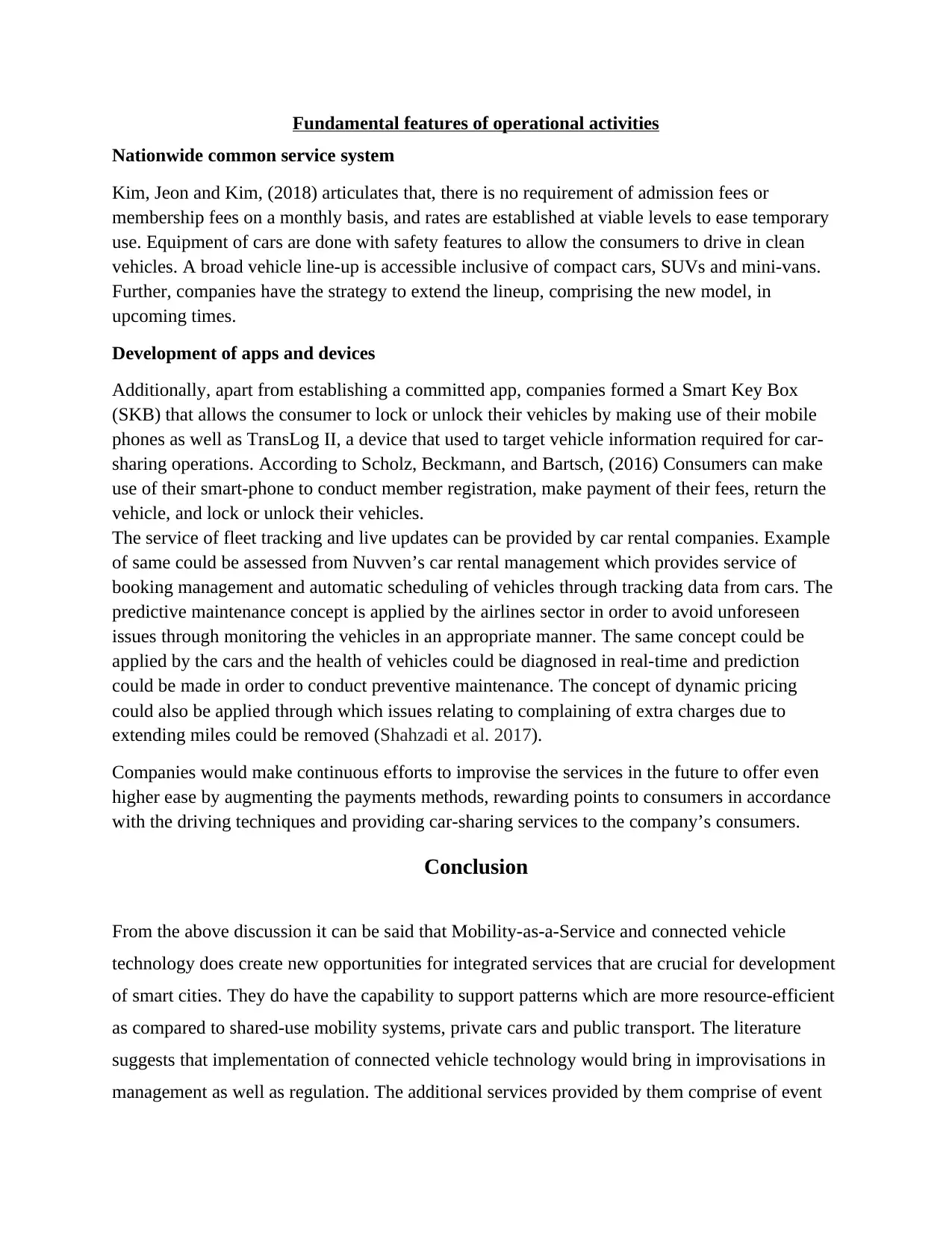
Fundamental features of operational activities
Nationwide common service system
Kim, Jeon and Kim, (2018) articulates that, there is no requirement of admission fees or
membership fees on a monthly basis, and rates are established at viable levels to ease temporary
use. Equipment of cars are done with safety features to allow the consumers to drive in clean
vehicles. A broad vehicle line-up is accessible inclusive of compact cars, SUVs and mini-vans.
Further, companies have the strategy to extend the lineup, comprising the new model, in
upcoming times.
Development of apps and devices
Additionally, apart from establishing a committed app, companies formed a Smart Key Box
(SKB) that allows the consumer to lock or unlock their vehicles by making use of their mobile
phones as well as TransLog II, a device that used to target vehicle information required for car-
sharing operations. According to Scholz, Beckmann, and Bartsch, (2016) Consumers can make
use of their smart-phone to conduct member registration, make payment of their fees, return the
vehicle, and lock or unlock their vehicles.
The service of fleet tracking and live updates can be provided by car rental companies. Example
of same could be assessed from Nuvven’s car rental management which provides service of
booking management and automatic scheduling of vehicles through tracking data from cars. The
predictive maintenance concept is applied by the airlines sector in order to avoid unforeseen
issues through monitoring the vehicles in an appropriate manner. The same concept could be
applied by the cars and the health of vehicles could be diagnosed in real-time and prediction
could be made in order to conduct preventive maintenance. The concept of dynamic pricing
could also be applied through which issues relating to complaining of extra charges due to
extending miles could be removed (Shahzadi et al. 2017).
Companies would make continuous efforts to improvise the services in the future to offer even
higher ease by augmenting the payments methods, rewarding points to consumers in accordance
with the driving techniques and providing car-sharing services to the company’s consumers.
Conclusion
From the above discussion it can be said that Mobility-as-a-Service and connected vehicle
technology does create new opportunities for integrated services that are crucial for development
of smart cities. They do have the capability to support patterns which are more resource-efficient
as compared to shared-use mobility systems, private cars and public transport. The literature
suggests that implementation of connected vehicle technology would bring in improvisations in
management as well as regulation. The additional services provided by them comprise of event
Nationwide common service system
Kim, Jeon and Kim, (2018) articulates that, there is no requirement of admission fees or
membership fees on a monthly basis, and rates are established at viable levels to ease temporary
use. Equipment of cars are done with safety features to allow the consumers to drive in clean
vehicles. A broad vehicle line-up is accessible inclusive of compact cars, SUVs and mini-vans.
Further, companies have the strategy to extend the lineup, comprising the new model, in
upcoming times.
Development of apps and devices
Additionally, apart from establishing a committed app, companies formed a Smart Key Box
(SKB) that allows the consumer to lock or unlock their vehicles by making use of their mobile
phones as well as TransLog II, a device that used to target vehicle information required for car-
sharing operations. According to Scholz, Beckmann, and Bartsch, (2016) Consumers can make
use of their smart-phone to conduct member registration, make payment of their fees, return the
vehicle, and lock or unlock their vehicles.
The service of fleet tracking and live updates can be provided by car rental companies. Example
of same could be assessed from Nuvven’s car rental management which provides service of
booking management and automatic scheduling of vehicles through tracking data from cars. The
predictive maintenance concept is applied by the airlines sector in order to avoid unforeseen
issues through monitoring the vehicles in an appropriate manner. The same concept could be
applied by the cars and the health of vehicles could be diagnosed in real-time and prediction
could be made in order to conduct preventive maintenance. The concept of dynamic pricing
could also be applied through which issues relating to complaining of extra charges due to
extending miles could be removed (Shahzadi et al. 2017).
Companies would make continuous efforts to improvise the services in the future to offer even
higher ease by augmenting the payments methods, rewarding points to consumers in accordance
with the driving techniques and providing car-sharing services to the company’s consumers.
Conclusion
From the above discussion it can be said that Mobility-as-a-Service and connected vehicle
technology does create new opportunities for integrated services that are crucial for development
of smart cities. They do have the capability to support patterns which are more resource-efficient
as compared to shared-use mobility systems, private cars and public transport. The literature
suggests that implementation of connected vehicle technology would bring in improvisations in
management as well as regulation. The additional services provided by them comprise of event
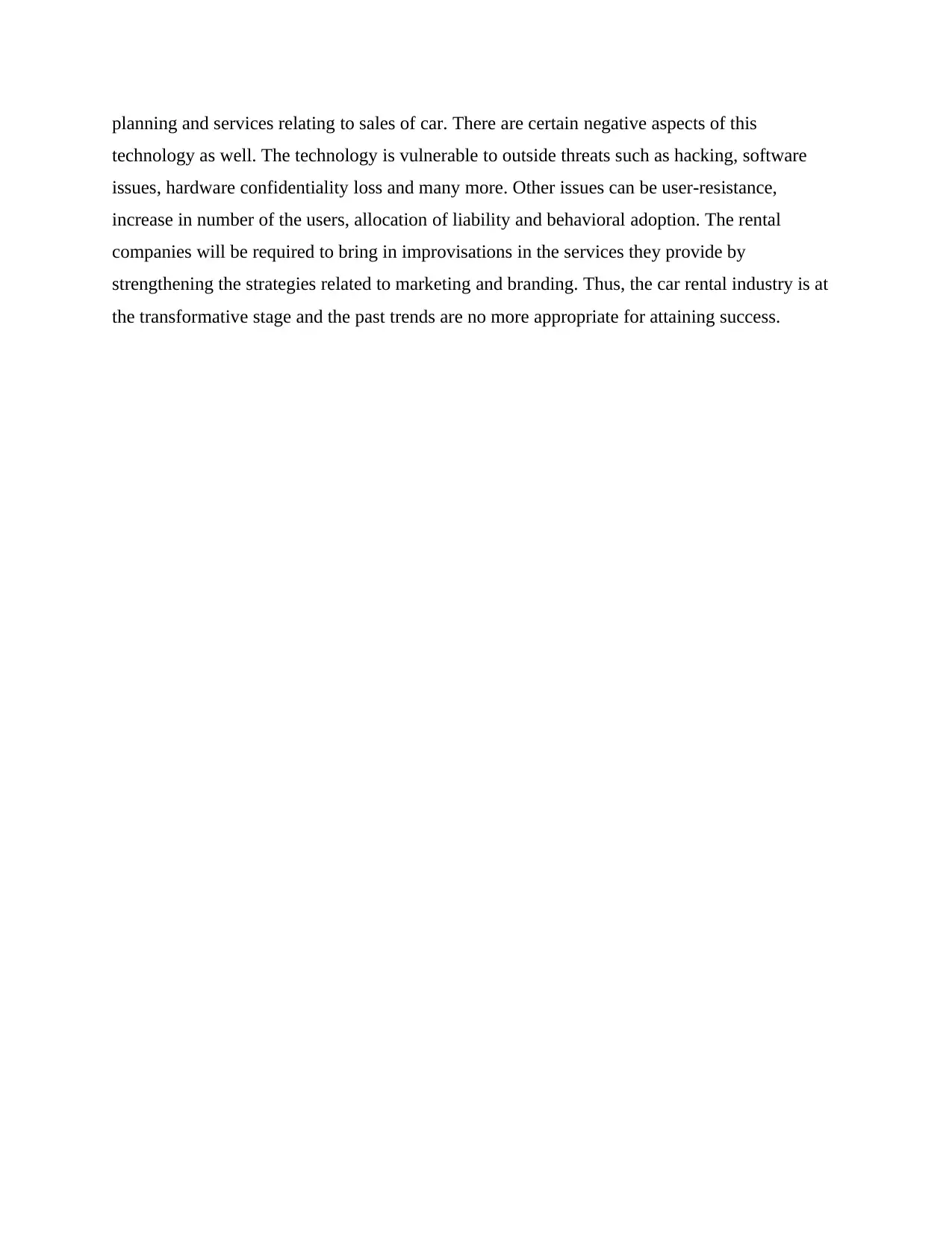
planning and services relating to sales of car. There are certain negative aspects of this
technology as well. The technology is vulnerable to outside threats such as hacking, software
issues, hardware confidentiality loss and many more. Other issues can be user-resistance,
increase in number of the users, allocation of liability and behavioral adoption. The rental
companies will be required to bring in improvisations in the services they provide by
strengthening the strategies related to marketing and branding. Thus, the car rental industry is at
the transformative stage and the past trends are no more appropriate for attaining success.
technology as well. The technology is vulnerable to outside threats such as hacking, software
issues, hardware confidentiality loss and many more. Other issues can be user-resistance,
increase in number of the users, allocation of liability and behavioral adoption. The rental
companies will be required to bring in improvisations in the services they provide by
strengthening the strategies related to marketing and branding. Thus, the car rental industry is at
the transformative stage and the past trends are no more appropriate for attaining success.
⊘ This is a preview!⊘
Do you want full access?
Subscribe today to unlock all pages.

Trusted by 1+ million students worldwide
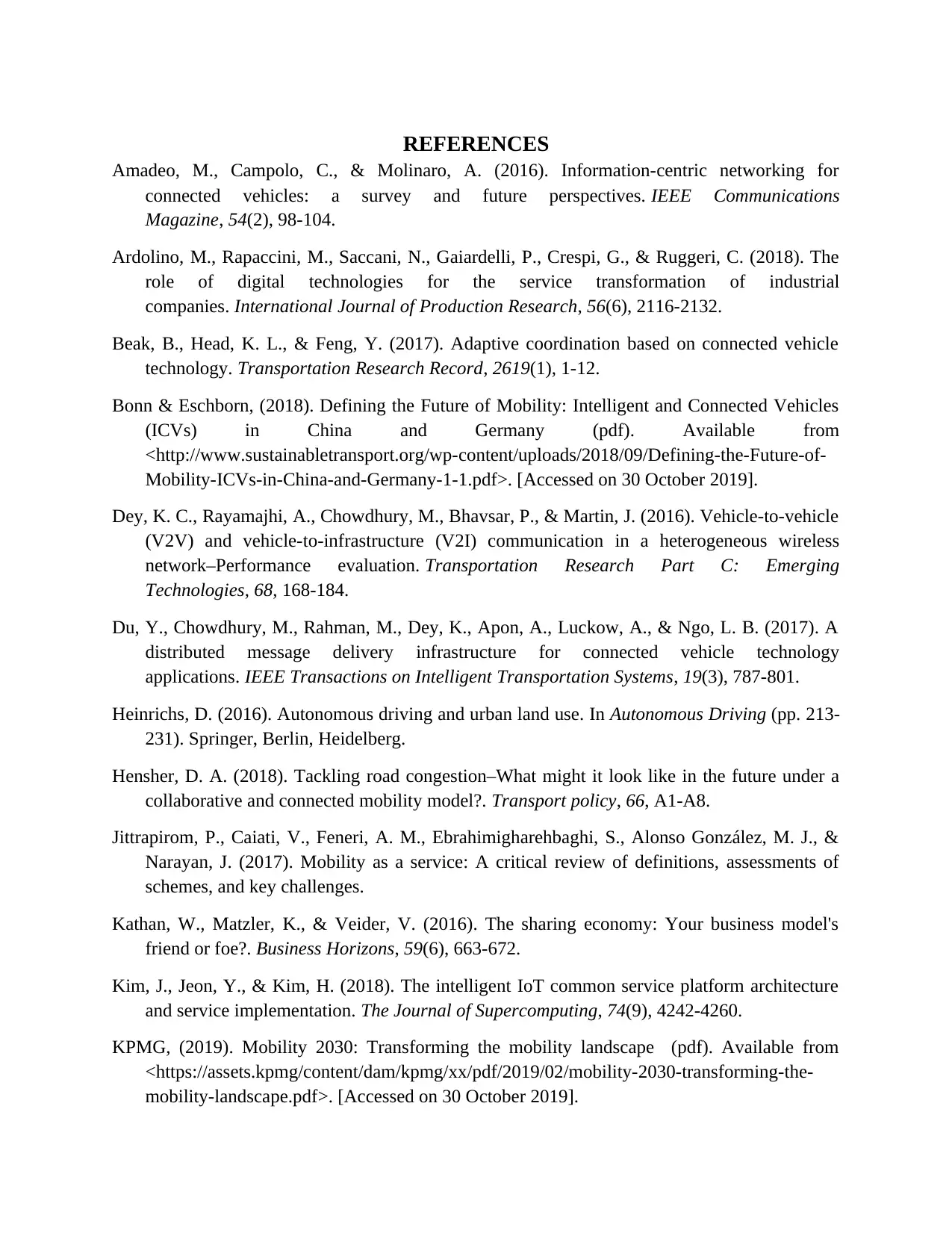
REFERENCES
Amadeo, M., Campolo, C., & Molinaro, A. (2016). Information-centric networking for
connected vehicles: a survey and future perspectives. IEEE Communications
Magazine, 54(2), 98-104.
Ardolino, M., Rapaccini, M., Saccani, N., Gaiardelli, P., Crespi, G., & Ruggeri, C. (2018). The
role of digital technologies for the service transformation of industrial
companies. International Journal of Production Research, 56(6), 2116-2132.
Beak, B., Head, K. L., & Feng, Y. (2017). Adaptive coordination based on connected vehicle
technology. Transportation Research Record, 2619(1), 1-12.
Bonn & Eschborn, (2018). Defining the Future of Mobility: Intelligent and Connected Vehicles
(ICVs) in China and Germany (pdf). Available from
<http://www.sustainabletransport.org/wp-content/uploads/2018/09/Defining-the-Future-of-
Mobility-ICVs-in-China-and-Germany-1-1.pdf>. [Accessed on 30 October 2019].
Dey, K. C., Rayamajhi, A., Chowdhury, M., Bhavsar, P., & Martin, J. (2016). Vehicle-to-vehicle
(V2V) and vehicle-to-infrastructure (V2I) communication in a heterogeneous wireless
network–Performance evaluation. Transportation Research Part C: Emerging
Technologies, 68, 168-184.
Du, Y., Chowdhury, M., Rahman, M., Dey, K., Apon, A., Luckow, A., & Ngo, L. B. (2017). A
distributed message delivery infrastructure for connected vehicle technology
applications. IEEE Transactions on Intelligent Transportation Systems, 19(3), 787-801.
Heinrichs, D. (2016). Autonomous driving and urban land use. In Autonomous Driving (pp. 213-
231). Springer, Berlin, Heidelberg.
Hensher, D. A. (2018). Tackling road congestion–What might it look like in the future under a
collaborative and connected mobility model?. Transport policy, 66, A1-A8.
Jittrapirom, P., Caiati, V., Feneri, A. M., Ebrahimigharehbaghi, S., Alonso González, M. J., &
Narayan, J. (2017). Mobility as a service: A critical review of definitions, assessments of
schemes, and key challenges.
Kathan, W., Matzler, K., & Veider, V. (2016). The sharing economy: Your business model's
friend or foe?. Business Horizons, 59(6), 663-672.
Kim, J., Jeon, Y., & Kim, H. (2018). The intelligent IoT common service platform architecture
and service implementation. The Journal of Supercomputing, 74(9), 4242-4260.
KPMG, (2019). Mobility 2030: Transforming the mobility landscape (pdf). Available from
<https://assets.kpmg/content/dam/kpmg/xx/pdf/2019/02/mobility-2030-transforming-the-
mobility-landscape.pdf>. [Accessed on 30 October 2019].
Amadeo, M., Campolo, C., & Molinaro, A. (2016). Information-centric networking for
connected vehicles: a survey and future perspectives. IEEE Communications
Magazine, 54(2), 98-104.
Ardolino, M., Rapaccini, M., Saccani, N., Gaiardelli, P., Crespi, G., & Ruggeri, C. (2018). The
role of digital technologies for the service transformation of industrial
companies. International Journal of Production Research, 56(6), 2116-2132.
Beak, B., Head, K. L., & Feng, Y. (2017). Adaptive coordination based on connected vehicle
technology. Transportation Research Record, 2619(1), 1-12.
Bonn & Eschborn, (2018). Defining the Future of Mobility: Intelligent and Connected Vehicles
(ICVs) in China and Germany (pdf). Available from
<http://www.sustainabletransport.org/wp-content/uploads/2018/09/Defining-the-Future-of-
Mobility-ICVs-in-China-and-Germany-1-1.pdf>. [Accessed on 30 October 2019].
Dey, K. C., Rayamajhi, A., Chowdhury, M., Bhavsar, P., & Martin, J. (2016). Vehicle-to-vehicle
(V2V) and vehicle-to-infrastructure (V2I) communication in a heterogeneous wireless
network–Performance evaluation. Transportation Research Part C: Emerging
Technologies, 68, 168-184.
Du, Y., Chowdhury, M., Rahman, M., Dey, K., Apon, A., Luckow, A., & Ngo, L. B. (2017). A
distributed message delivery infrastructure for connected vehicle technology
applications. IEEE Transactions on Intelligent Transportation Systems, 19(3), 787-801.
Heinrichs, D. (2016). Autonomous driving and urban land use. In Autonomous Driving (pp. 213-
231). Springer, Berlin, Heidelberg.
Hensher, D. A. (2018). Tackling road congestion–What might it look like in the future under a
collaborative and connected mobility model?. Transport policy, 66, A1-A8.
Jittrapirom, P., Caiati, V., Feneri, A. M., Ebrahimigharehbaghi, S., Alonso González, M. J., &
Narayan, J. (2017). Mobility as a service: A critical review of definitions, assessments of
schemes, and key challenges.
Kathan, W., Matzler, K., & Veider, V. (2016). The sharing economy: Your business model's
friend or foe?. Business Horizons, 59(6), 663-672.
Kim, J., Jeon, Y., & Kim, H. (2018). The intelligent IoT common service platform architecture
and service implementation. The Journal of Supercomputing, 74(9), 4242-4260.
KPMG, (2019). Mobility 2030: Transforming the mobility landscape (pdf). Available from
<https://assets.kpmg/content/dam/kpmg/xx/pdf/2019/02/mobility-2030-transforming-the-
mobility-landscape.pdf>. [Accessed on 30 October 2019].
Paraphrase This Document
Need a fresh take? Get an instant paraphrase of this document with our AI Paraphraser
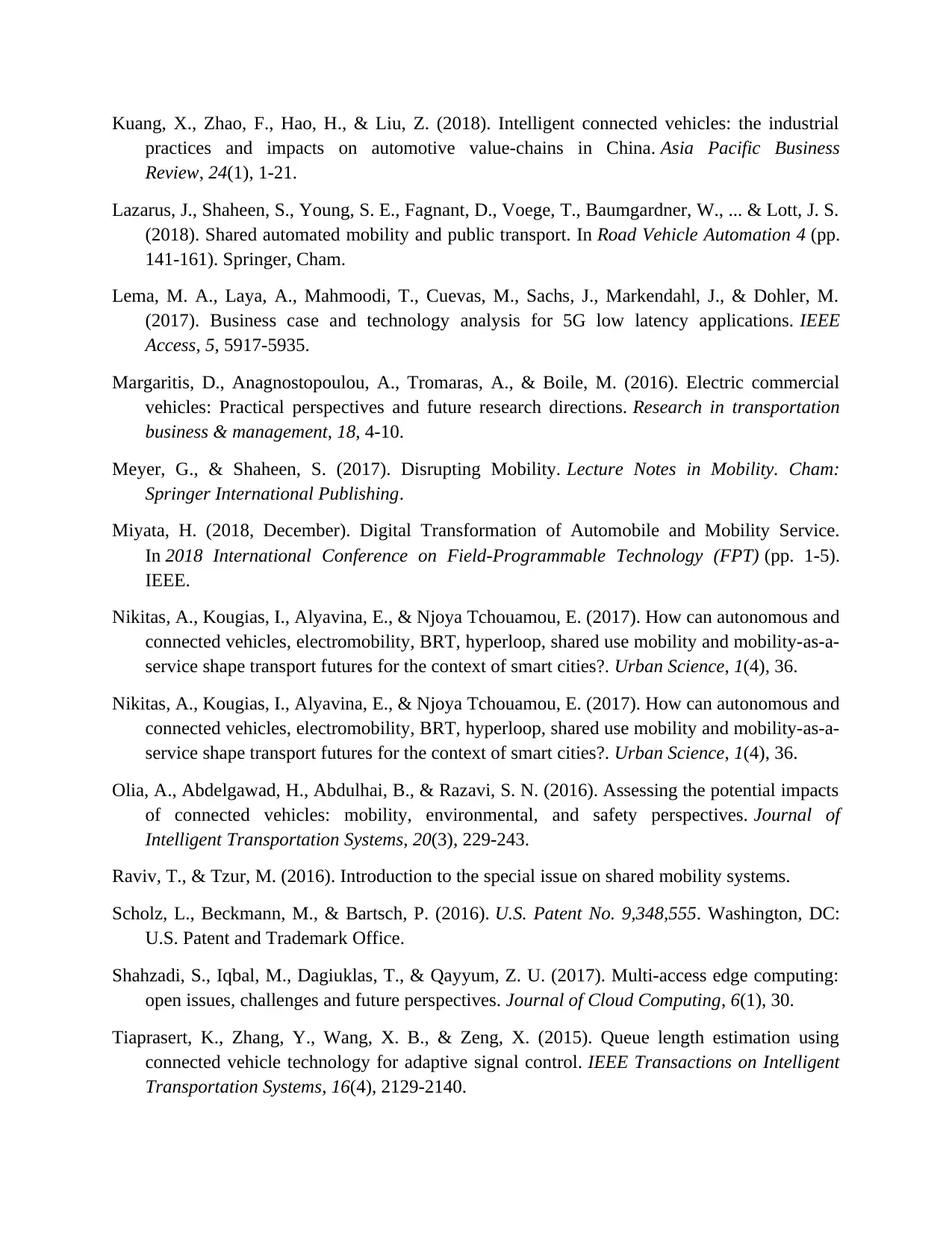
Kuang, X., Zhao, F., Hao, H., & Liu, Z. (2018). Intelligent connected vehicles: the industrial
practices and impacts on automotive value-chains in China. Asia Pacific Business
Review, 24(1), 1-21.
Lazarus, J., Shaheen, S., Young, S. E., Fagnant, D., Voege, T., Baumgardner, W., ... & Lott, J. S.
(2018). Shared automated mobility and public transport. In Road Vehicle Automation 4 (pp.
141-161). Springer, Cham.
Lema, M. A., Laya, A., Mahmoodi, T., Cuevas, M., Sachs, J., Markendahl, J., & Dohler, M.
(2017). Business case and technology analysis for 5G low latency applications. IEEE
Access, 5, 5917-5935.
Margaritis, D., Anagnostopoulou, A., Tromaras, A., & Boile, M. (2016). Electric commercial
vehicles: Practical perspectives and future research directions. Research in transportation
business & management, 18, 4-10.
Meyer, G., & Shaheen, S. (2017). Disrupting Mobility. Lecture Notes in Mobility. Cham:
Springer International Publishing.
Miyata, H. (2018, December). Digital Transformation of Automobile and Mobility Service.
In 2018 International Conference on Field-Programmable Technology (FPT) (pp. 1-5).
IEEE.
Nikitas, A., Kougias, I., Alyavina, E., & Njoya Tchouamou, E. (2017). How can autonomous and
connected vehicles, electromobility, BRT, hyperloop, shared use mobility and mobility-as-a-
service shape transport futures for the context of smart cities?. Urban Science, 1(4), 36.
Nikitas, A., Kougias, I., Alyavina, E., & Njoya Tchouamou, E. (2017). How can autonomous and
connected vehicles, electromobility, BRT, hyperloop, shared use mobility and mobility-as-a-
service shape transport futures for the context of smart cities?. Urban Science, 1(4), 36.
Olia, A., Abdelgawad, H., Abdulhai, B., & Razavi, S. N. (2016). Assessing the potential impacts
of connected vehicles: mobility, environmental, and safety perspectives. Journal of
Intelligent Transportation Systems, 20(3), 229-243.
Raviv, T., & Tzur, M. (2016). Introduction to the special issue on shared mobility systems.
Scholz, L., Beckmann, M., & Bartsch, P. (2016). U.S. Patent No. 9,348,555. Washington, DC:
U.S. Patent and Trademark Office.
Shahzadi, S., Iqbal, M., Dagiuklas, T., & Qayyum, Z. U. (2017). Multi-access edge computing:
open issues, challenges and future perspectives. Journal of Cloud Computing, 6(1), 30.
Tiaprasert, K., Zhang, Y., Wang, X. B., & Zeng, X. (2015). Queue length estimation using
connected vehicle technology for adaptive signal control. IEEE Transactions on Intelligent
Transportation Systems, 16(4), 2129-2140.
practices and impacts on automotive value-chains in China. Asia Pacific Business
Review, 24(1), 1-21.
Lazarus, J., Shaheen, S., Young, S. E., Fagnant, D., Voege, T., Baumgardner, W., ... & Lott, J. S.
(2018). Shared automated mobility and public transport. In Road Vehicle Automation 4 (pp.
141-161). Springer, Cham.
Lema, M. A., Laya, A., Mahmoodi, T., Cuevas, M., Sachs, J., Markendahl, J., & Dohler, M.
(2017). Business case and technology analysis for 5G low latency applications. IEEE
Access, 5, 5917-5935.
Margaritis, D., Anagnostopoulou, A., Tromaras, A., & Boile, M. (2016). Electric commercial
vehicles: Practical perspectives and future research directions. Research in transportation
business & management, 18, 4-10.
Meyer, G., & Shaheen, S. (2017). Disrupting Mobility. Lecture Notes in Mobility. Cham:
Springer International Publishing.
Miyata, H. (2018, December). Digital Transformation of Automobile and Mobility Service.
In 2018 International Conference on Field-Programmable Technology (FPT) (pp. 1-5).
IEEE.
Nikitas, A., Kougias, I., Alyavina, E., & Njoya Tchouamou, E. (2017). How can autonomous and
connected vehicles, electromobility, BRT, hyperloop, shared use mobility and mobility-as-a-
service shape transport futures for the context of smart cities?. Urban Science, 1(4), 36.
Nikitas, A., Kougias, I., Alyavina, E., & Njoya Tchouamou, E. (2017). How can autonomous and
connected vehicles, electromobility, BRT, hyperloop, shared use mobility and mobility-as-a-
service shape transport futures for the context of smart cities?. Urban Science, 1(4), 36.
Olia, A., Abdelgawad, H., Abdulhai, B., & Razavi, S. N. (2016). Assessing the potential impacts
of connected vehicles: mobility, environmental, and safety perspectives. Journal of
Intelligent Transportation Systems, 20(3), 229-243.
Raviv, T., & Tzur, M. (2016). Introduction to the special issue on shared mobility systems.
Scholz, L., Beckmann, M., & Bartsch, P. (2016). U.S. Patent No. 9,348,555. Washington, DC:
U.S. Patent and Trademark Office.
Shahzadi, S., Iqbal, M., Dagiuklas, T., & Qayyum, Z. U. (2017). Multi-access edge computing:
open issues, challenges and future perspectives. Journal of Cloud Computing, 6(1), 30.
Tiaprasert, K., Zhang, Y., Wang, X. B., & Zeng, X. (2015). Queue length estimation using
connected vehicle technology for adaptive signal control. IEEE Transactions on Intelligent
Transportation Systems, 16(4), 2129-2140.
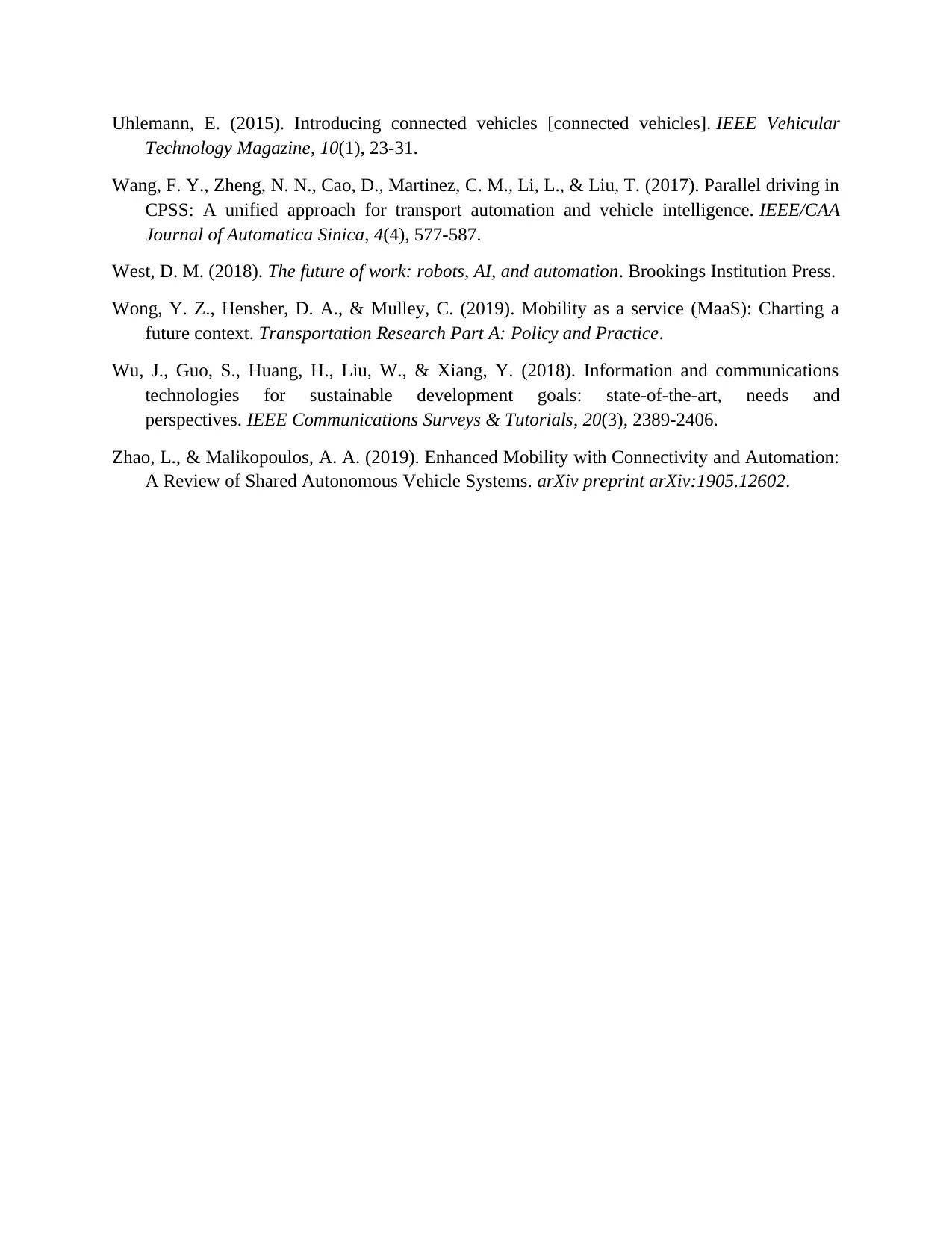
Uhlemann, E. (2015). Introducing connected vehicles [connected vehicles]. IEEE Vehicular
Technology Magazine, 10(1), 23-31.
Wang, F. Y., Zheng, N. N., Cao, D., Martinez, C. M., Li, L., & Liu, T. (2017). Parallel driving in
CPSS: A unified approach for transport automation and vehicle intelligence. IEEE/CAA
Journal of Automatica Sinica, 4(4), 577-587.
West, D. M. (2018). The future of work: robots, AI, and automation. Brookings Institution Press.
Wong, Y. Z., Hensher, D. A., & Mulley, C. (2019). Mobility as a service (MaaS): Charting a
future context. Transportation Research Part A: Policy and Practice.
Wu, J., Guo, S., Huang, H., Liu, W., & Xiang, Y. (2018). Information and communications
technologies for sustainable development goals: state-of-the-art, needs and
perspectives. IEEE Communications Surveys & Tutorials, 20(3), 2389-2406.
Zhao, L., & Malikopoulos, A. A. (2019). Enhanced Mobility with Connectivity and Automation:
A Review of Shared Autonomous Vehicle Systems. arXiv preprint arXiv:1905.12602.
Technology Magazine, 10(1), 23-31.
Wang, F. Y., Zheng, N. N., Cao, D., Martinez, C. M., Li, L., & Liu, T. (2017). Parallel driving in
CPSS: A unified approach for transport automation and vehicle intelligence. IEEE/CAA
Journal of Automatica Sinica, 4(4), 577-587.
West, D. M. (2018). The future of work: robots, AI, and automation. Brookings Institution Press.
Wong, Y. Z., Hensher, D. A., & Mulley, C. (2019). Mobility as a service (MaaS): Charting a
future context. Transportation Research Part A: Policy and Practice.
Wu, J., Guo, S., Huang, H., Liu, W., & Xiang, Y. (2018). Information and communications
technologies for sustainable development goals: state-of-the-art, needs and
perspectives. IEEE Communications Surveys & Tutorials, 20(3), 2389-2406.
Zhao, L., & Malikopoulos, A. A. (2019). Enhanced Mobility with Connectivity and Automation:
A Review of Shared Autonomous Vehicle Systems. arXiv preprint arXiv:1905.12602.
⊘ This is a preview!⊘
Do you want full access?
Subscribe today to unlock all pages.

Trusted by 1+ million students worldwide
1 out of 12
Related Documents
Your All-in-One AI-Powered Toolkit for Academic Success.
+13062052269
info@desklib.com
Available 24*7 on WhatsApp / Email
![[object Object]](/_next/static/media/star-bottom.7253800d.svg)
Unlock your academic potential
Copyright © 2020–2025 A2Z Services. All Rights Reserved. Developed and managed by ZUCOL.





